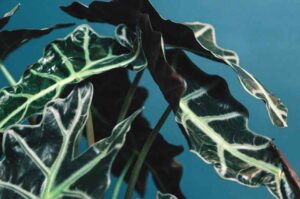Why are Staghorn ferns so Expensive? (explained)
Staghorn ferns are native to Australia and have a large trunk, with fronds coming out at different angles. Each frond has about ten leaflets arranged around a central vein on top of each leaflet (this is called “phyllotaxy”). The leaflets look similar to those found in other types of ferns, but they’re shaped differently because evolution has shaped the wind over time, which is an exciting concept!
You may be wondering how these ferns can be so expensive. The answer is simple:
Staghorn ferns are rare and difficult to find, which accounts for their high prices. They take time to grow and establish; they find use in decoration and ornaments. Moreover, they purify the air by killing harmful pathogens in our surroundings. They also find use in some medicines. All these factors make them an expensive and exotic species.

10 reasons why Staghorn Ferns are expensive
If you’ve ever strolled through a jungle, you know what Staghorn ferns are. If not, they’re epiphytic plants that grow on trees and other surfaces.
They have beautiful fronds and roots that look like blades of grass sprouting out of the ground, but they’re also scarce; thus are rare and very expensive to buy!
This article gives you an insight into 10 compelling reasons for the high cost of Staghorn Ferns:
1. It takes time to get the Staghorn Ferns well-established.
Staghorn ferns are very expensive because they take a long time to grow. They must also be repotted regularly and kept warm, but not too warm. A Staghorn fern will look like this when it is wholly established:
The leaves will be about 4 inches long, and the stem will be about 8 inches tall (or longer). It takes several years for these plants to get to the size and shape you want them to live forever!
2. Staghorn ferns require attention and care.
Staghorn ferns are not cheap to grow. They require a lot of attention and care, so you should be ready for many trips to the nursery or garden center.
They need high humidity levels to thrive, but this can also be difficult for some people because it’s hard to maintain consistent moisture levels in your home.
You have to invest in a humidifier if you live in an area with dry air (this is most common during winter months), especially if you’re trying to grow these ferns indoors over several months instead of just one season at a time or even longer!
You’ll also need frequent watering; these plants tend to survive and thrive during extended periods without rain.
However, they must have regular access to water throughout their lives so that they don’t become overly stressed by their environment before dying off altogether due to dehydration issues caused by insufficient water intake.
3. They reproduce by spores and require a particular environment.
There are two things to remember when you see Staghorn ferns in nurseries and garden centers. First, the plants will be sold as adult ferns. They had grown from spores produced on their underside as seedlings and then released when they matured and needed to reproduce.
The second thing to know about these plants is that they require a unique environment for germination—a warm, damp place where the soil stays moist for at least six months before being transplanted into a larger container or ground cover area where new growth can grow back again over time (and eventually produce more spores).
4. Staghorn has a fascinating history that’s helped keep the price high.
They’re native to tropical rainforests and grow on other plants, making them epiphytes. Epiphytes mean they grow on other plants, not because they need to but because they want to!
In addition, this fascinating plant has a long history of use as a herb in Asian medicine: it was used by Chinese soldiers who ate it before battle as an Aphrodisiac or “love potion” (though we’re pretty sure these rumors were exaggerated).
It’s also been known for centuries as an effective treatment for heart disease and cancer; today, it’s still used by some doctors treating patients with those conditions.
5. Staghorn ferns can turn any room into an instant jungle, so they are worth the extra cost.
Epiphytic plants are worth the extra cost because they turn any room into an instant jungle. In addition, they provide a lot of color and texture that you can’t get with other types of ferns.
If you’re new at growing things like this (or just not as good at it), then epiphytes might be perfect! They grow fast but don’t require much attention once established.
It would be best to keep them moist and away from direct sunlight during hot summer days when temperatures soar outside during the late afternoon/early evening hours.
6. Staghorn ferns clean air better than most plants.
Staghorn ferns are rare plants that can be extremely expensive, but they clean air better than most plants and are worth the cost if you have the resources.
Staghorn ferns remove formaldehyde and benzene from your home’s atmosphere. They also help to remove ammonia from the air, which is dangerous for people with respiratory issues.
The spore-bearing fronds of Staghorn ferns are very effective at removing pollutants from your home’s atmosphere. They work by absorbing chemicals in their leaves and then releasing them as waste products through their pores.
This property makes them great for cleaning up pet urine or other household messes that could harm children or pets who spend time in a room-sized space with these plants growing inside it!
7. Staghorn ferns are scarcely found.
Staghorn ferns are found in only a few places on earth and are so well adapted to their environments that they’re often considered living fossils.
They grow from rhizomes (rootlike structures) underground or hidden under rocks or leaves, making them difficult for humans to find without knowing precisely where they’re located. The Staghorn fern has long been used as an ornamental plant due to its striking appearance; its fronds look like horns!
8. Staghorn ferns are challenging to propagate.
Staghorn ferns are one of the most challenging plants to propagate. They require a sterile environment, lots of space, and humidity.
To be able to grow Staghorn ferns in your home or greenhouse, you will need:
- A sterile environment (no dirt)
- Space – at least 4 feet by 3 feet per plant
- Lots of moisture
9. Staghorn ferns are resistant to diseases.
Staghorn ferns are resistant to diseases and pests. This is especially important considering that Staghorn ferns proliferate so they can spread out quickly in your garden or landscape.
10. Excellent choice as an Indoor plant
Staghorn ferns are not easy to grow, but they make an excellent choice for those who want a unique look or want to decorate their home with something special.
The popularity of a plant can also affect its price. For example, if you buy a new fern for your home and it gets featured in an interior design magazine, you’ll see an increase in demand and, therefore, a price rise.
In addition to being used by designers and architects, plants can be popularized by celebrity endorsement. In this case, the Staghorn Fern is known as “the wall-mount tree” because it looks so good on display!
Effective tips to take care of Staghorn fern
Staghorn ferns are a particular type of plant that requires exceptional care, primarily due to their particular environmental needs.
They’re not compatible with dry environments and need to be kept moist. If their environment is too dry, the Staghorn ferns will wilt, but if it is too wet, the Staghorn ferns will start to rot. Therefore, it is crucial to fertilize your ferns frequently.
Here are some practical tips to keep in mind while caring for your ferns:
Water
Staghorn ferns must be watered in environments with too low humidity, as these roots will start to turn brown if they’re not watered. It would help if you generally water Staghorn ferns once a week, but you may need to water more or less based on their environment’s temperature and humidity.
If you are unsure whether your Staghorn fern needs water, it’s best to err on the side of caution and avoid overwatering.
When it comes to watering, Staghorn ferns prefer to be watered on the drier side. Therefore, allow the ground to dry out after some time between watering, and remove any drainage tray or saucer to prevent the plant’s roots from sitting in the water.
But when growing your fern outdoors, you should water more often in hot weather, as the plant will dry sooner.
Soil/Potting mix
Growing Staghorn ferns in a high-quality potting mix containing charcoal or other porous material would be best. It should be well-draining but not wet, and the fern should be watered only when the potting mix begins to dry out.
Mounting
To mount the ferns, you’ll require a starting lump of organic material like a peat, compost, moss, or soil base, but you shouldn’t need additional soil after.
Ferns are mounted using cork, compost, moss, or other plant matter to a wooden board, bark slab, or fishing pole, often using wire or a fishing line. As the ferns grow, they eventually hide the wires or fishing lines used to mount them.
Over time, the mass can grow large and heavy and may require remounting onto a bigger slab.
Humidity
It is important to keep Staghorn ferns moist. Humid environments are ideal for them. A dry climate will cause their leaves to turn brown and wrinkle. You can increase the humidity around them by misting with water or placing them on a pebble tray.
Fertilizer
Having Staghorn ferns fertilized is also essential because of their exclusive needs. The Staghorn fern grows more rapidly if you feed it with relatively fertile soil that is balanced and water-soluble. Because feeding frequency decreases through the cooler months, you can instead fertilize it once a month throughout the summer and spring months.
Sunlight
Staghorn ferns need a warm environment and a lot of sunlight. They prefer to be in a spot with full or partial sun. If they don’t get enough sunlight, they will lose their leaves. As a result, they won’t grow as well. If you live in a colder climate, you may need to give them supplemental light with grow lights.
They won’t do well if it’s too cold. So if you live in a cold climate, you’ll need to bring them inside during winter.
Different varieties of Staghorn ferns
There are about 18 other ferns in the Platycerium genus, some recognized as Staghorn ferns (Platycerium bifurcatum, for instance) and others harder to cultivate and usually cultivated only by enthusiasts or collectors.
The other species, however, tend to be more challenging to cultivate and are usually grown only by serious specialists. Here are the three most common varieties of Staghorn ferns:
- P. hillii– It is also a smaller species, with broad green fronds two to three feet long.
- P. veitchii– It is a smaller fern with a slow growth rate. It’s a perfect plant for beginners; it can tolerate more sunlight and is also known as the silver Staghorn fern.
- P. andinum– This plant originates in the Amazon and has narrow fronds compared to its counterparts.
Some Common problems of Staghorn ferns
The offspring of Staghorn ferns are typically not significantly affected by pests or diseases but can be infected by spider mites or the mark of fungi if nearby houseplants are affected by pests.
If infected, you will see a dark discoloration on a Staghorn fern, directly related to too much humidity or traveling fungal spores.
To treat the infected fern, use neem oil or other natural fungicides.
Staghorn fern is also infested by aphids and scale insects, such as mealybugs. To treat these pests, gently spray the plant with insecticidal soap.
It is also prone to a fungal ailment called black leaf spot, also known as Rhizoctonia. To treat them, trim out the affected regions of the plants and spray down the entire plant with a mild fungicide.
FAQs
Final words
Staghorn ferns are a type of fern that can be found in tropical rainforests. Unfortunately, they are scarce and difficult to find, which makes them very expensive.
However, if you have the resources like high humidity and constant water flow and want to clean your air more effectively than most other houseplants, Staghorn ferns are worth the cost!
We hope this article has helped you understand the importance of epiphytic plants and why they deserve to be treated with care.
These beautiful ferns have been around for centuries and have become necessary in any home that wants to look stylish or feel more relaxed.
So, if you’re looking for a way to spruce up your home, consider getting one of these beauties today!






